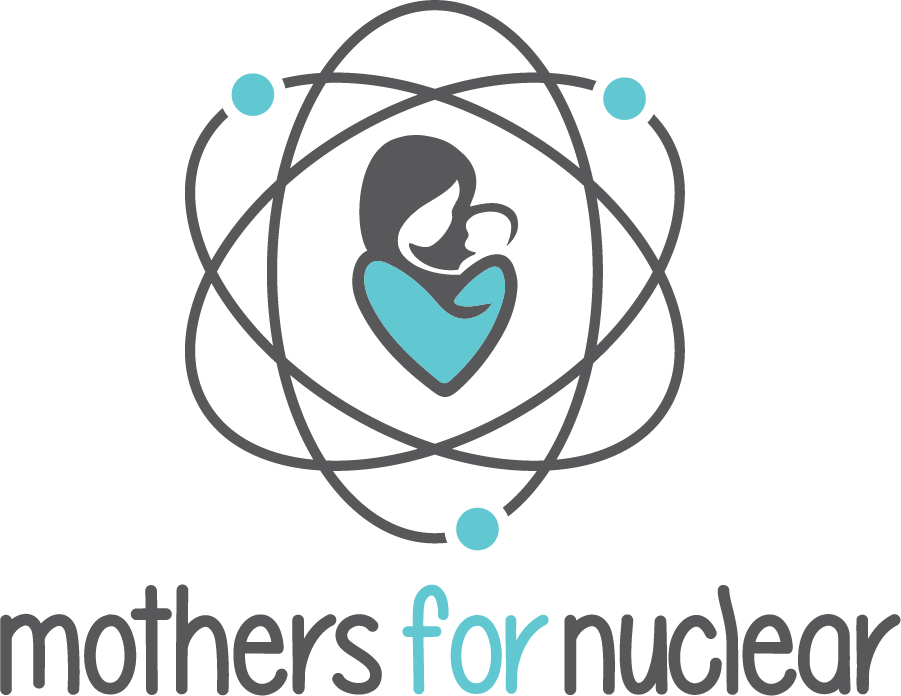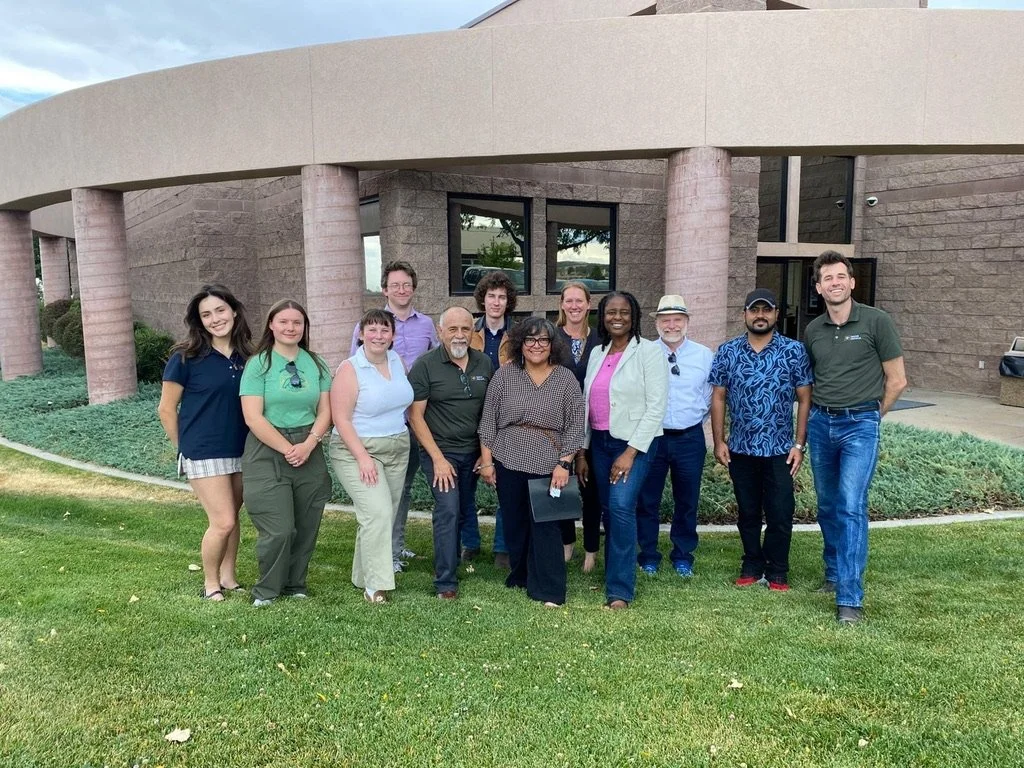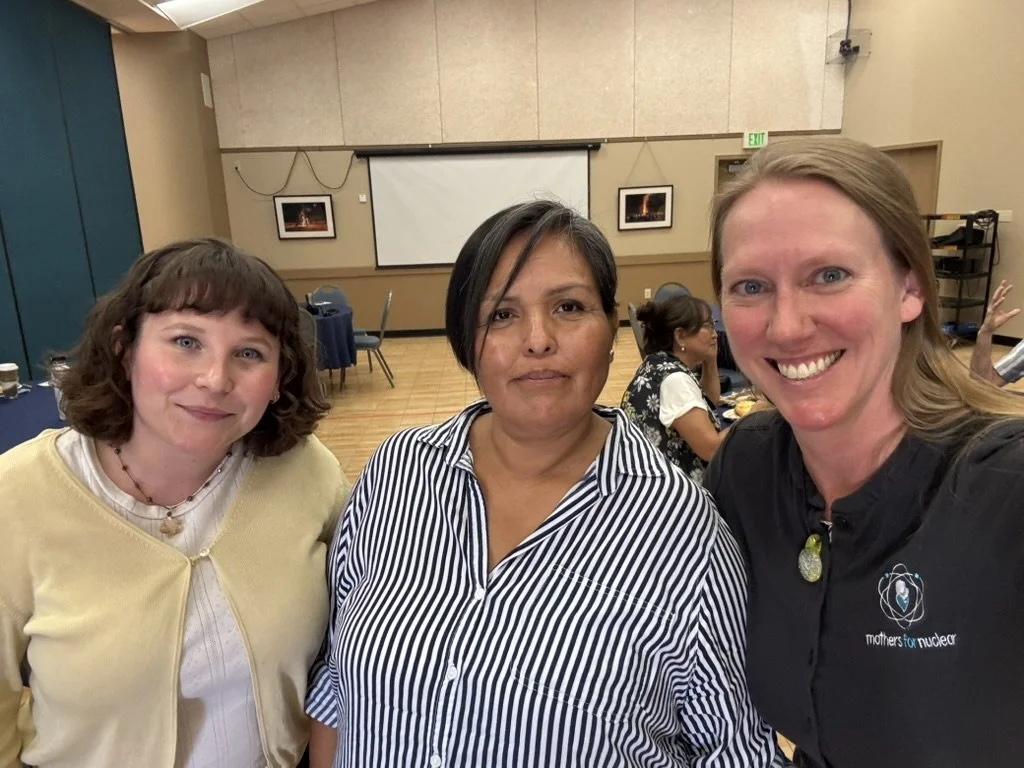Utah CBS Listening Sessions and Workshops
Mothers for Nuclear and partners Organize listening sessions and Workshops to Connect With Local utah Communities on Nuclear Topics and Radiation Risk
Utah has a host of concerns related to energy, from the cancelled six reactors with UAMPS and NuScale to many other existing and new proposals for energy-related infrastructure. After we hosted a Collaboration Based Siting workshop in Salt Lake City, in June 2024, word spread about our initiative, and Talia Hansen, the San Juan County Economic Development Director, reached out to our consortium to come back to Utah. Living and working in San Juan County, she’s seen the unique and dynamic relationship between various San Juan community members and the uranium fuel cycle.
Talia takes a photo of the mockup uranium fuel pellet (courtesy of NEI, ANS also has a pretty great version of these).
Talia did an amazing job navigating some tense and emotional conversations - this is how nuclear communications should happen, from the heart.
So, in August 2025, we organized a series of community engagement events with a heavy focus on native participation. The historical backdrop includes the federal government and private mining companies exploiting indigenous workers, particularly the Navajo, from the 1940s through the 1980s, in efforts to extract uranium. And the modern landscape has Energy Fuels Resources shipping uranium ore from Pinyon Plain Mine in 2024, over Navajo land, Hopi land, and Ute Mountain Ute Tribe land, to White Mesa Uranium Mill, creating outrage among several tribal nations. We were luckily able to visit the White Mesa mill (which you can read about HERE) just prior to our other activities, to gain some perspective about their operations and their perception of local community concerns.
Scott Lathrop, a member of the yak titʸu titʸu yak tiłhini (ytt Tribe) and the CEO of Native Nuclear, highlighted the importance of fostering trust with native communities in a safe environment, and listening to concerns. “What people have to understand is that a community like the Navajo Nation isn't quite ready to forget about what has happened in the past,” Lathrop said. “They feel that the government or industry hasn't really met their obligation to their community. There's a real problem with trust. You have to go back and rebuild that trust with people and with tribal communities. You need a relationship basis, before you try to deal with issues or problems.” This includes plans for future energy infrastructure.
The first event, a tribal listening session, aimed to hear out indigenous concerns. We sat in a circle together. Introductions happened in a clockwise, or “sun-wise” manner to honor Navajo tradition. In keeping with lessons learned from other workshops, we believe connecting with humans in their native language is connecting, so Heather attempted to introduce herself in Navajo (and apparently didn’t offend anyone). Yáʼátʼééh. Members shared their clans, stories of kidnapping and the Long Walk, and fears about uranium and radiation, along with the systemic hurt Native people have endured. We heard of lessons passed from generation to generation, and of nonprofits, past and present, focused on community aid. Their familial ties to each other and their land instigated the movement to establish Bears Ears National Monument. They shared the meaning and practice of Hozho, the active balance between you, your soul, the landscape, and the other beings around you.
Operations Associate at Mothers for Nuclear, Fereshteh Bunk, cried during the impactful listening session, and said she was touched how connected the tribal members were to each other and the environment. We got feedback from some of our guests at the end saying they don't always feel comfortable sharing personal stories like this about uranium and fears around radiation, but that they really did feel safe here talking with us. After listening and bonding, we enjoyed a traditional meal of fry bread, mutton, bean soup, blue corn mush colored with juniper ash, and rehydrated peaches.
Former ANS President Lisa Marshall found value in strictly listening, without responding to points raised by the members of the group. Marshall was the emcee for workshops on the second and third days. “We do a lot of talking [as] industry, right?,” Marshall said. “More times than not it’s unidirectional, and it takes quite a bit to shut up and listen, not respond to people, but just listen to understand the situation.”
While Navajo member and conservation activist Tara Benally enjoyed the sessions, she said that uranium mining is an extractive process that has contaminated Navajo land, without remediation. “We don't see it as a good thing. It has devastated our families, our land, our water, our air, I mean, pretty much our livelihood,” Benally said. “Since the 1950s, uranium has been dumped in various communities and really no cleanup has been done of the deposits. The majority of our water is contaminated, and none of that has been addressed at all.” Benally said that while clean up efforts led by the federal government or state agencies would help build trust and nuclear facilities can provide high paying jobs, their community has never seen positive effects from the nuclear industry.
Fereshteh and Heather with Tara
An environmental philosophy, tied to the earth, also inspires Benally. “You have to see how much love we have for this land, how much we understand and recognize that this land sustains us. It's who we are,” Benally said. “When we say we are the land, and the land is us, we see it in our DNA. We see it in our whole makeup. Whatever is in the ground, that's who we are as well. That connection is far more worth fighting for than all the energy and the minerals in the earth is worth. What are you exhausting from the earth and throwing it away?”
In terms of research, the consortium aimed to test that moral framing and trust building helps change minds and battle misinformation better than with scientific information alone. Radiation risk expert Dr. Robert Hayes of NC State said the team wanted to figure out if this communication technique would enable people to make risk informed decisions related to nuclear energy in multiple capacities, including management of used nuclear fuel.
We spent a a lot of time around tables, getting to know each other.
The team connecting with Utah policymakers
“If you were anti-nuclear and that was part of your narrative as to why you're a good person, that can make it next to impossible for that person to actually see the facts right,” Hayes said. “So what we wanted to do is see if you could help somebody in that situation using these communication techniques that the psychologists and what the literature said you're supposed to do.” In terms of the workshop results, Hayes said, people not opposed to nuclear became very pro-nuclear, people who considered themselves an ally may have been converted to an advocate, and people who were strictly anti-nuclear perhaps shifted some, conceding certain points but still feeling a lot of skepticism. Across the board, people moved closer towards support of nuclear.
Sk Azmaeen Bin Amir, a nuclear engineering student at NC State, said the workshop successfully enabled people to make decisions on knowledge of nuclear technology rather than fear.
Fear has taken hold of several indigenous tribes, however, shaped largely by the past historical injustices tribes have faced related to uranium mining. This legacy remains strong today. HaulNo!, a grassroots Indigenous organization, formed in response to the uranium ore deliveries between Pinyon Plain Mine and White Mesa Uranium Mill, starting in 2024. Members have demonstrated along the route, on State Routes 191 and 264, with signs showing the radioactive symbol and demanding cessation of the transport.
The workshops sought to reach many people in the community that had concerns about these trucks, which pass through the Hopi Nation, the Navajo Nation, and the Ute Mountain Ute Tribe. During a tabling session with Garrin Palmer from Energy Fuels Inc. and Heather from Mothers for Nuclear, Dr. Hayes described how described how no health impacts would result from crashing the trucks. The material is dirt they dug out of the ground in an area with slightly higher concentration of natural uranium compared to other dirt, at about 1%. Eating the slightly radioactive dirt could cause you to get sick from the dirt, not the radiation.
Listening to this conversation, astounded, two Navajo women asked “Oh my gosh. How come no one told us this isn’t dangerous?”
Lathrop said it is important to note that tribal people view the world through a sovereign lens in which they have a sovereign right to make decisions in the area and have strong stewardship responsibility to assure the environment and territory is secured for future generations. Of the 574 federally recognized tribes, Lathrop said that most are anti-nuclear today because of historical wrongs that happened in the mining days in Wyoming, Navajo Country, and Utah. “I want to say they haven't had the opportunity to hear the whole story about nuclear,” Lathrop said. “And I don't think they've seen the complete picture of how the nuclear industry is the most friendly industry to the environment. I think that's where maybe minds will be changed.”
Native Nuclear aims to engage tribal communities about the nuclear sector in general. “Tribal nations can play a great big part in this for the benefit of their tribe and also the benefit of the environment,” Lathrop said. He also acknowledges, “Trust takes time. Our goal isn’t persuasion, it’s relationship-building.”
Scott sharing his philosophy with a packed room - nuclear is great at protecting the things he cares about. The term “energy density” doesn’t necessarily mean much to some people, but to hear that nuclear allows us to take less from our planet, we then get huge amounts of emission-free electricity, and then there is little waste - that resonates.
Rather than a threat, Lathrop views nuclear energy as a crucial tool in protecting the environment on Native lands. “I also discovered that nuclear power aligns almost 100% with tribal philosophy of protection of the environment,” Lathrop said. “Our philosophy is when you use resources, you're supposed to take a little, maximize the use, and return little. Well, nuclear power is the only one out there that has that very small footprint on the environment, but produces a heck of a lot of power.”
Heather gifted a uranium glass pendant to Mr. Curtis Yanito.
Mr. Yanito’s daughter shared her hand-made jewelry and ornaments with the team after the workshop.
25th Navajo Nation Councilmember Curtis Yanito entered the workshop on the final day skeptical but curious. When Lisa Marshall presented on the energy density of uranium and what used fuel actually looks like, Yanito had become interested enough that he wanted to keep the demonstration uranium pellet. Later, Heather showed her uranium glass necklace to Yanito, and he was pretty amazed. She almost walked away, but then decided to offer the pendant to Yanito as a gift, along with a UV keychain light to make it glow. He asked some questions about what would happen if it broke (don’t hurt yourself on glass shards!) and then said that he would show it to others in his community.
Marshall emphasized the importance of listening to community members and addressing their concerns as a way for the nuclear industry to gain the trust of the public. While the Utah workshops focused on used fuel storage, Marshall said that the community may prioritize other issues, and nuclear communicators need to be able to pivot to all aspects of nuclear. “I think that we, on the nuclear side, still have to pay attention to the cues that are being received and be willing to change or adapt to what topic individuals want to talk about,” Marshall said. “To be authentic, means to me, you have to listen, and you're connecting based on what is being said in the moment, as opposed to trying to necessarily take it somewhere else, because you have a point to make.”
Nuclear infrastructure, including used fuel storage sites could bring nuclear technology to Native communities. That would produces jobs and STEM programs to train people in radiation protection at the facility before moving on to other careers in nuclear; it could be a launching point for young people. It could create nuclear tourism, with nuclear professionals from around the country and world visiting to learn and share best practices. But that’s not really the point. Yet.
-Mothers for Nuclear
(Jack Austin, interviewer and contributor)
These two ladies were polar opposites regarding their behavior during our workshop on the third day - one was heckling MfN as we gave our portion of the presentation, asking for data and saying maybe we should get some facts as part of our plug. She LOVED Dr. Hayes’ presentation. The other was scowling around at the back during Dr. Hayes’ presentation, threatening to walk out because he was so offensive and this was NOT the way to do nuclear communications.
Turns out these ladies were friends from a previous life and have now reconnected. They were both great! But it highlights just part of the challenge we have when trying to engage with diverse audiences on a large scale. People respond differently to different messaging, and can even become so turned off that they refuse to engage further. The philosophy of our workshop, building trust first with MfN and NN, and then bringing the radiation risk facts from a nuclear engineering professor, appears to strike a delicate balance.
After our last workshop, we had the opportunity to see some local sights.
We hiked to some native cliff dwellings and a natural bridge near Blanding.
Our partners at Native Nuclear put together this great video sharing scenes from both the White Mesa Uranium Mill Tour and our other activities over the weekend.
You can also watch our Mothers for Nuclear portion of the presentation that we gave on Saturday in Blanding, HERE.















